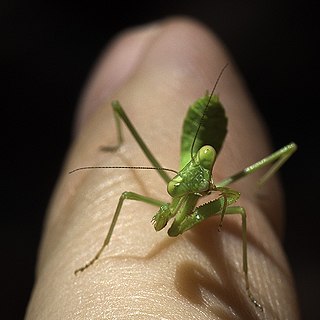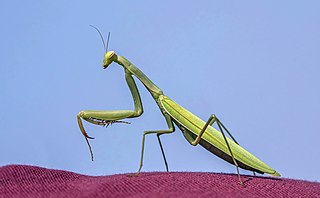
The Carolina mantis is a species of praying mantis of the subfamily Stagmomantinae.

The Chinese mantis is a species of mantis native to Asia and the nearby islands. In 1896, this species was accidentally introduced by a nursery tender at Mt. Airy near Philadelphia, United States. Tenodera sinensis often is erroneously referred to as Tenodera aridifolia sinensis because it was at first described as a subspecies of Tenodera aridifolia, but Tenodera sinensis is now established as a full species.

Mantidae is one of the largest families in the order of praying mantises, based on the type species Mantis religiosa; however, most genera are tropical or subtropical. Historically, this was the only family in the order, and many references still use the term "mantid" to refer to any mantis. Technically, however, "mantid" refers only to members of the family Mantidae, and not the 14 remaining families of mantises. Some of the most recent classifications have promoted a number of the mantid subfamilies to the rank of family, e.g. Iridopterygidae, Sibyllidae, Tarachodidae, Thespidae, and Toxoderidae, while other classifications have reduced the number of subfamilies without elevating to higher rank.

Iris oratoria, known by the common name Mediterranean mantis, due to humans first studying it in lands around the Mediterranean Sea, is a species of praying mantis. Its range is expanding in the Middle East, Western Asia and the United States.

Stagmomantis is a genus consisting of 21 species of mantises native to the Americas.

Stagmomantis californica, common name California mantis, is a species of praying mantis in the family Mantidae that is native to the western United States.
Stagmomantis gracilipes, common name Arizona tan mantis, is a species of praying mantis in the family Mantidae. They are native to the south-western United States, Mexico and Central America.
Stagmomantis montana, common name Mountain mantis, is a species of praying mantis in the family Mantidae. They are native to Mexico and Central America. S. montana sinaloae has been identified as a subspecies.

Stagmomantis limbata, common name bordered mantis, bosque mantis, Arizona mantis, or New Mexico praying mantis, is a species of praying mantis native to North America, most prevalent in the south-western United States. This beneficial insect is green or beige in color and grows up to around 3 inches long.
Arizona mantis is a common name applied to various species of praying mantis native to Arizona, particularly:
Stagmomantis tolteca is a species of praying mantis in the family Mantidae.
Paralepetopsis floridensis is a species of sea snail, a true limpet, a marine gastropod mollusk in the family Neolepetopsidae, one of the families of true limpets.

Mantises are an order (Mantodea) of insects that contains over 2,400 species in about 460 genera in 33 families. The largest family is the Mantidae ("mantids"). Mantises are distributed worldwide in temperate and tropical habitats. They have triangular heads with bulging eyes supported on flexible necks. Their elongated bodies may or may not have wings, but all Mantodea have forelegs that are greatly enlarged and adapted for catching and gripping prey; their upright posture, while remaining stationary with forearms folded, has led to the common name praying mantis.
S. californica may refer to:
S. maculata may refer to:

Didymops floridensis, the Florida cruiser, is a species of cruiser in the family of dragonflies known as Corduliidae. It is found in North America.
Hesperotettix floridensis, known generally as the Florida purple-striped grasshopper or Florida purple-striped locust, is a species of spur-throated grasshopper in the family Acrididae. It is found in North America.
Amitermes floridensis, commonly known as the Florida darkwinged subterranean termite, is a species of eusocial insect in the family Termitidae. It feeds on rotting wood, reached by a network of tunnels. It is endemic to west central Florida and was first described in 1989.







